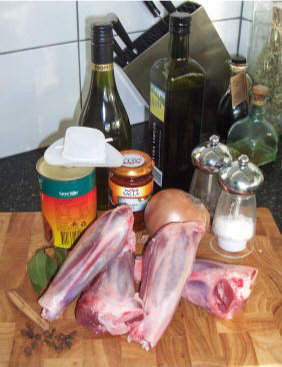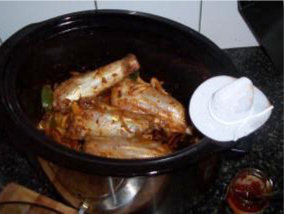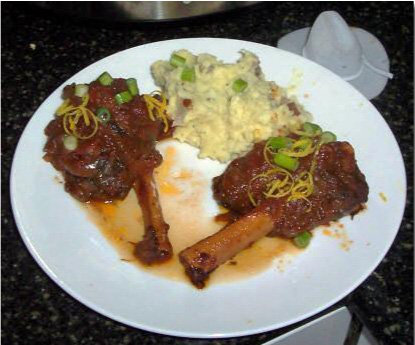Slow cooked lamb shanks
About the ingredients

You really need Frenched lamb shanks for this
recipe. You can try it with ordinary shanks but then you ll have to put
off you plans of being a supermodel for another year. Frenched lamb
shanks are shanks that have been trimmed by the butcher to remove the
excess fat and tendon. In up-market stores you may find fancy ones
where the meat has been cut away from the bone at the bottom and pushed
towards the top in the manner of a skirt tucked into the pantaloons for
the purpose of riding a bicycle. You don t need anything as poncy as
that. After long slow cooking that presentation aspect will have
disappeared. Your more down-to-earth butcher will have just chopped off
the top and bottom that s where most of the rubbish is with the belt
saw and then maybe trimmed a little more with a knife. They will be fine
for this recipe and they are currently (June 2008) selling from $2 to $3 each at the
Vic
Market. (As usual expect to pay about double that in a supermarket).
About the slow cooking
An electric slow cooker or crock pot is ideal
for this recipe. (If you are new to using a slow cooker you might want
to read The White Hat Guide to
using a Crock Pot or Slow Cooker) Alternatively you can use a flat casserole dish
in an oven on low heat. A heavy bottomed pan on the stove is possible if you are
prepared to monitor it throughout the day (or night).
Ingredients

The ingredients below feed two. If you live alone, slow
cooked meals reheat well in fact they are often better after
reheating. And if you live alone you may find the line would you like
to come in for some slow cooked lamb shanks? works better than would
you like to come in for a nightcap?
- 4 Frenched lamb shanks
- 1 large onion
- 6 cloves
- 1 cinnamon stick
- 2
fresh bay leaves (or 1 dried one)
- 4 teaspoons tomato paste
- 1 can diced
tomatoes
- 2 cups dry white wine
- freshly ground salt and pepper
Cooking
If you are using a slow cooker, first use a pan on the stove.
If you are using a casserole dish then that is all you need.
In the pan or casserole dish on the stove, heat a little oil. On
medium heat, brown the shanks lightly turning to get some colour on each
side maybe 2 to 3 minutes total. Don t worry if there is a bit of
smoke rising from the pan unless the smoke alarm is nearby. Remove
shanks and add chopped onion and garlic to soften, adding a little more
oil if necessary. Add tomato paste and continue to stir and fry for
about a minute. You are now ready to deglaze the pan. It is important to
ascertain whether the wine is of a suitable quality for cooking so taste
a little first. You cannot make a proper judgement on less than half a
glass. Add the remaining half glass to the pan which should create a
quantity of steam and enable you to scrape any crunchy bits off the
bottom of the pan. Add the can of chopped tomatoes, the cinnamon stick
broken in half (the perfectionists among you may wish to measure the
cinnamon in order to find out where the exact half-way point is) and the
cloves. If like me, you don t mind coming across the surprise of the
occasional clove in the finished dish they can go straight in. However
for dinner party guests I am more likely to take a small peeled onion
and stud it pin-cushion style with the cloves so that it can be removed
at the end of the cooking. Season with plenty of freshly ground pepper,
a little salt and possibly some sugar. (One thing that may need
adjusting in subsequent cookings is the amount of salt and sugar added
at the early stages. Tomato pastes vary in their bitterness and canned
tomatoes vary in their sweetness. If the dish turns out too bitter the
first time, add more sugar the next time round.)

If you are using a slow cooker, place the shanks in the bottom and
cover with the other ingredients from the pan. If you are using the
casserole dish in the oven, simply return the shanks. In either case I
find the ideal situation is where the shanks are in one layer (otherwise
you need too much liquid) and the sauce does not quite cover the shanks.
Whether using a casserole dish or slow cooker form a cover with baking
paper or aluminium foil that keeps the cooking steam close to the
shanks. Cook slowly (slow cooker up to 8 hours; oven minimum of 3 hours
at about 180 degrees) turning the shanks occasionally. Don t worry if
things have browned a bit on top (as distinct from shrivelled to
charcoal). Turn it over and blend it in that will add to the richness
of the sauce. From time to time top up the liquid with a little white
wine, having checked that it is still suitable for cooking. You can use
stock such as thin chicken stock but there is no need to use rich stocks
as the final sauce will be thick and rich enough without any assistance.
The shanks are ready when the meat is easily separating from the bone.
Serving

Two shanks per person with the sauces from the pan (which should need
no reduction or extra ingredients) should be enough for
anyone except Pacific Island rugby players or 14 year old boys. There is no
point combining them with subtle side servings. The big concentrated
rich flavour of the shanks and the sauce will clobber them. For
accompaniments you can try mashed spuds which will soak up the sauce. I
particularly like a small pasta (like conchigloette or pignilina)
cook, drain then while hot mix in plenty of chopped parsley or similar
greens and plenty of butter there goes the good intentions of using
low fat Frenched shanks. During the hours the shanks have been cooking
you might notice that the display panel on your microwave has been
scrolling messages such as slow cooking is a passing fad and today s
food needs today s technology . To keep the microwave happy you might heat up
some frozen beans or peas. Finally, for garnish you might try grating
some lemon rind onto the shanks or some gremolata (finely chopped
parsley, garlic & lemon rind). Use any garnish you like but it needs to
be fresh, bright and strong to contrast with the richness of the shanks.
Like all recipes, try your own variants until you make it our own,
Particularly in winter, lamb shanks are a great and
cheap comfort food. And if your new-found companion doesn't want to come
inside for supper, they don't know what they're missing out on.
If you found this recipe useful then subscribe to
our
free food newsletter for more recipes in
this style.
|
|
Copyright © 1995 - 2025
White Hat.
|
___________________
 ___________________
___________________
Related pages